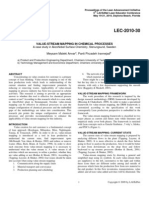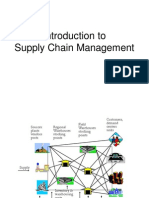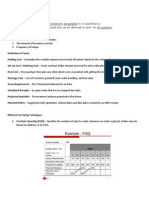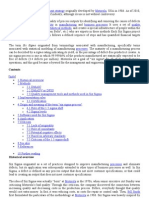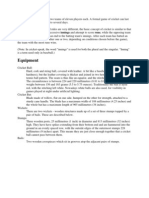Case Study - Applying Six Sigma To Cricket
Case Study - Applying Six Sigma To Cricket
Uploaded by
Asel Juárez ViteCopyright:
Available Formats
Case Study - Applying Six Sigma To Cricket
Case Study - Applying Six Sigma To Cricket
Uploaded by
Asel Juárez ViteOriginal Title
Copyright
Available Formats
Share this document
Did you find this document useful?
Is this content inappropriate?
Copyright:
Available Formats
Case Study - Applying Six Sigma To Cricket
Case Study - Applying Six Sigma To Cricket
Uploaded by
Asel Juárez ViteCopyright:
Available Formats
Case Study: Applying Six Sigma to Cricket
http://www.isixsigma.com/implementation/sports/case-study-applying-six...
Nitesh Verma November 11, 2013 18 Mike was the best batsman in the Club Acme cricket team. The probability of Club Acmes winning a match was higher when he batted well and scored more runs. His batting form had been declining the past few months, however, affecting the teams win percentage and revenues. Improving Mikes consistency with the bat would help the team win more matches. The team hired a Lean Six Sigma Black Belt to analyze the factors affecting Mikes batting and develop an improvement plan. A project team was formed with the chief batting coach as the project leader. Batting average: Total number of runs scored by a batsman divided by the number of times he has been dismissed. Bowled: One of the ways in which a batsman can be dismissed; the batsman is dismissed when the ball hits the wickets while he attempts to play the ball. Bowler: Player who delivers ball to opposing teams batsmen; may be right- or left-armed. The average number of runs scored by Mike per inning was 32.5 for the last 50 matches (January 2011 to December 2011) compared to his benchmarked 40 runs per inning. This lowered number of runs negatively affected Club Acmes match results; the team won only 36 percent of the matches they played in the same timeframe. (See Figure 1.) Caught behind: A catch taken by the wicket-keeper or the fielders in the slip (standing behind the batting wicket) that results in the dismissal of the batsman. Caught (outfield): A catch taken by a fielder (other than the wicket-keeper, fielders in the slip and the bowler himself) that results in the dismissal of the batsman. Crease: The batting zone. Dismissal: When a batsman is dismissed, he cannot continue batting any further in the same inning. Inning: Each teams turn to bat or bowl is called one inning. In a one-day game, each inning consists of a maximum 50 overs where one team bats while the other bowls. Keeper (wicket-keeper): Fielder standing behind the batsman to catch or stop the ball. LBW (leg before wicket): The batsman is adjudged out if he is hit by the ball before taking his shot. Over: Six legal deliveries by a bowler makes one over. Pitch: The main strip of playing area, often short grass. Run out: The batsman is adjudged out when a member of the fielding team hits the wickets with the ball when the batsman is outside the crease while attempting to take a run. Seam bowler: A bowler who usually bowls fast (speed of 120 kilometers per hour or more). Slip fielder: See keeper. Spinner: Slow bowlers who spin the ball using their wrist or fingers. Stance: Posture of the batsman while batting on the cricket pitch. A batsman usually uses a closed stance (the front shoulder pointing toward the bowler while batting) or an open stance (the batsman standing at a slightly wider angle compared to the closed stance). Strike rate: Number of runs scored by a batsman per 100 deliveries. Stump: Wicket used.
Cricket: Description and Glossary
Cricket is one of the worlds most popular games. It is played between two teams of 11 players. In a one-day cricket game, each team is allowed to bat for a maximum of 50 overs and the team scoring more runs is declared the winner. Each team has a combination of batsmen (players who score the runs), bowlers (players who deliver the ball to the batsmen from the opposing team) and a wicket-keeper.
Problem Statement
Process Capability
Forty runs in a completed inning was the benchmark and set as the lower specification limit (LSL) for assessing process capability. Any complete innings in which Mike scored fewer than 40 runs was considered a defect. Mike played 50 matches in 2011 and as he usually batted at the top of the batting order, he was dismissed in all 50 matches. He scored more than 40 runs in only 14 out of 50 innings.
Figure 1: Run Chart of Runs
1 de 8
08/01/2014 01:56 p.m.
Case Study: Applying Six Sigma to Cricket
http://www.isixsigma.com/implementation/sports/case-study-applying-six...
Table 1: Batting Statistics for Mike in 2011 Innings played (N) 50
Defects (< 40 runs)
36
Mean
32.52
Median
15
Standard deviation
39.47
DPMO (defects per million opportunities)
720,000
Sigma (Zst)
0.92
The project team determined the improvement target by using the 1-sample percent-defective test (Figure 2).
Figure 2: Summary of 1-Sample Percent Defective Test
The 1-sample percent-defective test compared Mikes current defective rate to a target of 50 percent. With a 0.05 level of significance and a calculated p-value of 0.001, the test verified statistically that Mikes current percent defective was greater than 50 percent. At a 90 percent confidence level, the true percent defective was between 59.74 percent and 82.21 percent. (The confidence interval (CI) quantifies the uncertainty associated with estimating the percent defective from the sample data.) The team concluded that if Mike scored 40 runs or more in 50 percent the matches played, it would be a statistically significant improvement.
Root Cause Analysis of Batting Performance
The team analyzed data for all of the innings in which Mike scored fewer than 40 runs. In 30 out of 36 defective innings (83 percent), Mike was dismissed for fewer than 20 runs. Once Mike crossed 20 runs, the probability of playing a longer inning was high he was dismissed only 6 times between 20 and 40 runs out of the overall 50 completed innings. Why was Mike dismissed so often before scoring 20 runs? The team used a Pareto chart to identify the dismissal types when: Mike scored fewer than 20 runs Mike scored more than 20 runs
Figure 3: Types of Dismissals for Innings with Fewer Than 20 Runs
2 de 8
08/01/2014 01:56 p.m.
Case Study: Applying Six Sigma to Cricket
http://www.isixsigma.com/implementation/sports/case-study-applying-six...
Figure 4: Types of Dismissals for Innings with More Than 20 Runs
Being caught behind was the most frequent cause for dismissal when Mike scored fewer than 20 runs: 50 percent compared to 10 percent when he scored more than 20 runs. Why was Mike getting caught by the keeper and the slip fielders so often at the start of his innings? Club Acmes statistician provided the shot data for Mike as shown in Figure 5.
Figure 5: Type of Stroke Relating to Type of Shot Played (Left = Type of Stroke, Right = Attacking Shot Played)
Of Mikes caught behind dismissals at the start of his innings, 67 percent occurred while he was playing attacking strokes. In particular, the attacking shots (a subset of attack strokes) that contributed most often to the caught behind dismissals were three types of high-risk shots: hooks, pulls and upper cuts. A Closer Look at the Shots
3 de 8
08/01/2014 01:56 p.m.
Case Study: Applying Six Sigma to Cricket
http://www.isixsigma.com/implementation/sports/case-study-applying-six...
The team analyzed the success of these shots played by Mike at the start of his innings and later in the games. By looking at Mikes historical strike rate, it was clear that he used to play 25 balls to score 20 runs. The team tested the success of his hook, pull and upper cut shots during the first 25 balls played by Mike in comparison to shots played after 25 balls. The strike rate for balls 26 and higher was almost double compared to the first 25 balls. Compared to 10 dismissals out of 28 attempts in the first 25 balls, Mike was dismissed just 4 times in 117 attempts after playing 25 balls.
Table 2: Shot Analysis for Mike Statistics Total shots played 0-25 Balls 28 26+ Balls 117
Number of dismissals
10
% defective
35.71%
3.42%
90% CI
(21 53)%
(1 8)%
p-value
0.000
Balls per dismissal
2.80
29.25
The conclusion from this analysis was that Mike had to avoid playing those higher-risk shots in the initial stages of his innings. Other Inputs for Batting In a brainstorming session, the project team identified the various factors related to runs being scored and created the cause-and-effect diagram shown in Figure 6. Items highlighted in red are the ones deemed to be most critical and that were investigated further.
Figure 6: Factors Related to Runs Scored
The project team did not find any difference in Mikes performance when batting first or when chasing a target. His performance on flat pitches, however, was better compared to green pitches. What was affecting Mikes batting while playing on green pitches? The batting coach suggested the team look at the type of bat Mike used and his batting position. While the type of bat used (light or heavy) did not have any measurable impact, Mike performed better on green pitches when he was not required to open the batting (bat first) and face the new ball bowlers. On green pitches, his batting average in fourth position was 52.6 compared to 12.1 when Mike opened the batting, a statistically significant difference (Figure 7).
Figure 7: Pitch Versus Batting Position
4 de 8
08/01/2014 01:56 p.m.
Case Study: Applying Six Sigma to Cricket
http://www.isixsigma.com/implementation/sports/case-study-applying-six...
The project team collected data for Mikes batting and shot selection against different types of bowlers. Shots played by Mike that did result, or could have resulted, in a dismissal were identified as false or risky and termed defective. The proportion of defective shots was contrasted against the total number of balls played against each type of bowler. As shown in Table 3 and Figure 8, there were differences among the percent defectives for different bowling types at a 0.05 level of significance (p-value: 0.000). From the analysis, it was concluded that Mike played more false or risky shots while playing left-arm seam bowlers (21.48 percent) in comparison to other bowlers such as right-arm seam bowlers and spinners.
Table 3: Bowling Style Effects on Mike Bowling Style Balls Played Defective Shots % Defective 95% CI
Right-arm seam
793
65
8.20
(6.38, 10.33)
Left-arm seam
298
64
21.48
(16.95, 26.58)
Leg spin
257
31
12.06
(8.34, 16.68)
Off spin
436
33
7.57
(5.27, 10.47)
Left-arm spin
199
26
13.07
(8.72, 18.56)
Figure 8: Percent Defective Comparison Chart
The chief batting coach analyzed video footage of Mike batting against left-arm seam bowlers. Mike played a left-arm seam with a closed stance, similar to what he used for right-arm seam bowlers. The orthodox stance blocked him before he played a shot, and he ended up playing around his front pad (protective clothing). He also kept his backswing too straight, playing across the line (moving laterally to the incoming ball) and ended up chest-on to the ball. Mike was advised to play left-arm seam with an open stance and wider back-lift. With an open stance, he could better align himself up to the incoming ball. For a wider back-lift, he had to pick his bat over the off stump or the first slip area (angle of the bat while playing the ball changes depending upon the starting position of the bat) rather than over the middle stump.
The Improvement Plan
After the analysis was complete, the project team summarized its results and made its improvement recommendations for Mike and Club Acme.
Table 4: Action Plan Root Cause Description Improvement Responsibility
Batting Style
Hooks, pulls and upper cuts were contributing to the maximum number of dismissals at the start of Mikes innings.
Mike needs to avoid playing these high-risk shots in the initial stages of his innings (the first 20 to 25 balls). Mike should be placed in fourth position in matches played on green pitches.Continuously changing the batting order based on pitch
Mike, batting coach, team captain
Pitch Conditions Mikes batting average on green pitches is significantly lower compared to his performance on flat pitches. The problem is
Team captain, batting coach
5 de 8
08/01/2014 01:56 p.m.
Case Study: Applying Six Sigma to Cricket
http://www.isixsigma.com/implementation/sports/case-study-applying-six...
facing the new ball at the start of his innings on conditions would negatively impact other green pitches that suit seam bowling. He does players. As Mikes batting is consistent at all well batting lower down in the order on green pitches. positions on flat pitches, Mike would bat at fourth position in all matches irrespective of pitch conditions. Bowling Style Mike tends to play more false or risky shots while facing left-arm seam bowlers. Mike needs to play left-arm seam bowlers with Mike, batting coach, team an open stance and wider back-lift. There would be mandatory left-arm net bowlers at team practice sessions. manager
Project Outcome and Benefits
The action plan recommended by the Black Belt and the project team helped improve Mikes batting consistency. He scored an average of 49.32 runs per inning in the 28 innings of the first six months of 2012 compared to his previous baseline average of 32.52 runs per inning, as shown in Figure 9. In addition, Club Acme improved its win rate to 54 percent (16 out of 28).
Figure 9: Batting Improvement Project Results
If You Loved This Article, You Might Also Love
1. Listen to Customers and Change the Process Accordingly An iSixSigma Case Study 2. A Six Sigma Case Study Tutorial for IT Call Center Part 1 of 6 3. Identifying Six Sigma Projects Using Customer Data An iSixSigma Case Study 4. A Six Sigma Case Study Tutorial for IT Call Center Part 6 of 6
Tags: Case Study, cricket, example, sports
Comments
Cyril
11-11-2013, 04:04
Good one! During training sessions on problem solving tools, We used to use case study of cricket. The class room was fully exited about the game and was useful in finding the root cause using 5 Why analysis & Fish bone diagram. Thanks for sharing Reply
Sebastian
11-11-2013, 18:29
did a great case! Thanks for sharing this interesting case study. Reply
Jason Jones
12-11-2013, 12:00
Love the case study! As a 6Sigma practioner and an avid cricketer, this certainly strikes all the right chords with me! Reply
6 de 8
08/01/2014 01:56 p.m.
Case Study: Applying Six Sigma to Cricket
http://www.isixsigma.com/implementation/sports/case-study-applying-six...
Manuel S.Kumar
12-11-2013, 20:14
Its amazing !! six sigma in cricket why not when things are out of control. Reply
santosh MBB
12-11-2013, 20:49
Good one.. I have a similar case study related with Golf which I will share shortly on this forum.. Reply
Katie Barry
13-11-2013, 11:17
Hi Santosh! Im happy to hear youre working on a case study related to golf you can submit it here when youre ready: http://www.isixsigma.com/submit-article/ Reply
Vijay verma
12-11-2013, 21:55
Its really interesting and well presented Reply
Shree Nanguneri
12-11-2013, 22:20
Hi Mr. Verma, Great way to showcase this as an example. I was under the impression that someone was working on a predictive model, but havent come across it. In your case study, for some reason you stopped at the recommendations without validating them. So in reality, you would need to enter the control phase after showing the breakthrough for Mike and then predicting Mikes performance batting average or performance using the critical Xs and then comparing it with the actual performance of Mike. Then you may want to look at the Standardized Residual Diagnostic Plots to validate your model. Until then, your recommended solution stays challenged at the hypothesis stage in the analyze-improve phase waiting for validation, maybe at the FMEA with the new waiting to be tested RPNs. I would be happy to assist and work with you on the remaining parts to closure, if you are interested. I can be reached at nanguneri@yahoo.com if you wish to continue this. Thanks anyhow! Good luck and keep it up as these examples may provide a better way for students to relate to these concepts. Dr. Shree Reply
shree nanguneri
13-11-2013, 13:51
Here is an example that shows the DMAIC process applied to sports, yet the customers are not quite willing to accept change [http://www.isixsigma.com/implementation/sports/roger-hart-pivotalswing-interview/?type=LINL#!] Reply
Ger Grace
15-11-2013, 12:13
All. I love the DMAIC approach and minitab tools. Having said that, I think this is a great case study but not in the way it was intended i.e. Team analysed to death what could have been identified by ASKING mike and his coach. Six sigma is at its best when all the obvious improvements have been already implemented and you want the last few %. Using lots of tools to conclude the obvious is what gives practitioners a bad name. I offer this opinion with the best of intentions. Reply
Khurram Naveed
17-11-2013, 19:26
One of the best case,studies I have seen in recent times, very refreshing, thanks for sharing.. Reply
Satyam Joshi GOOD ONE.
23-11-2013, 01:48
7 de 8
08/01/2014 01:56 p.m.
Case Study: Applying Six Sigma to Cricket
http://www.isixsigma.com/implementation/sports/case-study-applying-six...
CAN BE USED FOR IMPROVING ORDER BOOKING FOR SALES TEAM. Reply
Muhammad Habibullah Excellent Analysis Reply
18-12-2013, 09:51
Puneet Gupta
18-12-2013, 09:53
Sir,,I want ask some question releted this case study.. Reply
Katie Barry
18-12-2013, 10:11
@ Puneet Gupta Please go ahead and post your questions here. Reply
Puneet Gupta
19-12-2013, 05:20
Maam, I want knowhow do apply six sigma in cricket?.Full.explain Reply
Katie Barry
19-12-2013, 08:11
@ Puneet Gupta This is the only article that iSixSigma has published specifically about applying Six Sigma to cricket. But the entire website has articles and discussions that describe how to use Six Sigma. I suggest you click around, use our Search functionality, etc. to find more information that would assist you. Reply
Nitesh Verma
19-12-2013, 21:51
@ Puneet Gupta, If this is a general query regarding tips for six sigma application, as mentioned by Katie, please refer articles and discussions in the forums. In case, there is a specific business case or problem you are referring to, kindly provide some details. Reply
8 de 8
08/01/2014 01:56 p.m.
You might also like
- 3 - 4 Anchor Hybrid DefenseDocument97 pages3 - 4 Anchor Hybrid Defensegusalini1271% (7)
- Basketball Skills RubricDocument1 pageBasketball Skills Rubricapi-257201032No ratings yet
- JDA Supply Chain Strategiest Hugh Hendry - SCS - L1Document38 pagesJDA Supply Chain Strategiest Hugh Hendry - SCS - L1AmitNo ratings yet
- IIE Simulation Competition Dalhousie UniversityDocument37 pagesIIE Simulation Competition Dalhousie Universitydaug2489100% (1)
- Working Out The Psychology of Sport and Exercise by Justine J. Reel PH.D PDFDocument241 pagesWorking Out The Psychology of Sport and Exercise by Justine J. Reel PH.D PDFHana FebriantiNo ratings yet
- Premiere Manufacturing Case Study, Step 1: Background: The Present SituationDocument161 pagesPremiere Manufacturing Case Study, Step 1: Background: The Present Situationaqsa imran100% (1)
- Implementing Integrated Business Planning: A Guide Exemplified With Process Context and SAP IBP Use CasesFrom EverandImplementing Integrated Business Planning: A Guide Exemplified With Process Context and SAP IBP Use CasesNo ratings yet
- Six Sigma: A Case Study On Mumbai DabbawalaDocument49 pagesSix Sigma: A Case Study On Mumbai Dabbawaladheeraj0% (1)
- Applying Lean Six Sigma To Records ManagementDocument37 pagesApplying Lean Six Sigma To Records Managementtanto98100% (1)
- BMW IMAC Form Completeness Six Sigma Case StudyDocument2 pagesBMW IMAC Form Completeness Six Sigma Case StudySteven BonacorsiNo ratings yet
- Manly Junior Rugby Union Tour Booklet 2015Document20 pagesManly Junior Rugby Union Tour Booklet 2015api-259806728No ratings yet
- 3-3 Defense: Understanding The BasicsDocument69 pages3-3 Defense: Understanding The Basicsjgfitz100% (2)
- Slant Defense Vs RunDocument16 pagesSlant Defense Vs Runjcarbon2100% (3)
- Six Sigma Case Studies - Vytra Call Center PDFDocument2 pagesSix Sigma Case Studies - Vytra Call Center PDFVbaluyoNo ratings yet
- Applying Six Sigma at 3MDocument13 pagesApplying Six Sigma at 3MDaniel ChavezNo ratings yet
- Six Sigma Project Charter TemplateDocument1 pageSix Sigma Project Charter Templatevvaditya1994No ratings yet
- Six Sigma at WiproDocument16 pagesSix Sigma at Wiprosheru101No ratings yet
- LSS - Software DevelopmentDocument15 pagesLSS - Software DevelopmentMadhavaKrishnaNo ratings yet
- Master Black Belt ProgramDocument10 pagesMaster Black Belt ProgramBoo BalanNo ratings yet
- Implementation of Just in Time Production Through KanbanDocument11 pagesImplementation of Just in Time Production Through KanbanCindy Putri100% (1)
- Wire MoldDocument29 pagesWire MoldSakshi KhuranaNo ratings yet
- Just-In-Time and Kanban: Push or Pull?Document43 pagesJust-In-Time and Kanban: Push or Pull?cristianpetriceanNo ratings yet
- DB2 PrecompileDocument10 pagesDB2 PrecompileSampad Sekhar0% (1)
- Graded Quiz - Using Probability Distributions - CourseraDocument10 pagesGraded Quiz - Using Probability Distributions - CourseranguyenvandongNo ratings yet
- (Quality Control Process Chart) : Pt. Jatim Taman Steel MFGDocument2 pages(Quality Control Process Chart) : Pt. Jatim Taman Steel MFGDenny Angriawan Nurcahya0% (1)
- Applications of Statistics SixSigmaDocument30 pagesApplications of Statistics SixSigmaSanz LukeNo ratings yet
- MM 1 010 Lot Size CalculationDocument4 pagesMM 1 010 Lot Size Calculationaudi404No ratings yet
- LEC-2010 Value-Stream Mapping The Chemical ProcessesDocument5 pagesLEC-2010 Value-Stream Mapping The Chemical ProcessesMustafa Mert SAMLINo ratings yet
- Lean Case StudiesDocument8 pagesLean Case StudiesTengku SmyNo ratings yet
- Toyota Motor Manufacturing U.S.A Inc.: Group 10Document8 pagesToyota Motor Manufacturing U.S.A Inc.: Group 10shishirNo ratings yet
- Toyota Production System PDFDocument7 pagesToyota Production System PDFZaib RehmanNo ratings yet
- Lean Principle On RMSDocument11 pagesLean Principle On RMSAhmad SyihanNo ratings yet
- Using DMAIC Six Sigma To Systematically Improve Shopfloor Production Quality and CostsDocument20 pagesUsing DMAIC Six Sigma To Systematically Improve Shopfloor Production Quality and CostsArturo ValentinNo ratings yet
- PP GL E-Glossary For PPDocument19 pagesPP GL E-Glossary For PPsatyajitsadekar123No ratings yet
- Japanese Total Quality Control, TQM, Deming's System of Profound Knowledge, BPR, Lean and Six Sigma Comparison and Discussion 20401461111189425Document26 pagesJapanese Total Quality Control, TQM, Deming's System of Profound Knowledge, BPR, Lean and Six Sigma Comparison and Discussion 20401461111189425HafeezAbdullahNo ratings yet
- 00 - Service Operations Management OutlineDocument6 pages00 - Service Operations Management OutlineSagar BadnakheNo ratings yet
- Introduction SCMDocument55 pagesIntroduction SCMUsama Jahangir BabarNo ratings yet
- Sap Mmphysical InventoryDocument9 pagesSap Mmphysical Inventorykumarranjit228No ratings yet
- 3a 2 Card Kanban System CalculationsDocument2 pages3a 2 Card Kanban System CalculationsJose OrtegaNo ratings yet
- Just in TimeDocument56 pagesJust in TimeJuvi CruzNo ratings yet
- Kaizen CostingDocument19 pagesKaizen Costingcloudynyte1100% (1)
- Lot Sizing in MRPDocument5 pagesLot Sizing in MRPMariztine MirandillaNo ratings yet
- Using A Simulation Game Approach To Teach Pull andDocument8 pagesUsing A Simulation Game Approach To Teach Pull andPiereSalasNo ratings yet
- Production Planning HierarchyDocument3 pagesProduction Planning HierarchyDr. Mahmoud Abbas Mahmoud Al-Naimi100% (2)
- Supply Chains A Managers GuideDocument193 pagesSupply Chains A Managers GuideLoredana Mihaela BobeicaNo ratings yet
- Asq Six Sigma Black Belt Certification Project Affidavit/Verification FormDocument2 pagesAsq Six Sigma Black Belt Certification Project Affidavit/Verification FormErvin PregNo ratings yet
- Six Sigma - Key To Productivity ImprovementDocument34 pagesSix Sigma - Key To Productivity ImprovementdheerajsonamNo ratings yet
- Lean Manufacturing AssessmentDocument10 pagesLean Manufacturing AssessmentjvanandhNo ratings yet
- Kanban: Presented byDocument12 pagesKanban: Presented byshrutesNo ratings yet
- Six Sigma Sample QuestionsDocument2 pagesSix Sigma Sample Questionsbreezeee100% (1)
- Warehousing & Storage Techniques - Lecture 5Document38 pagesWarehousing & Storage Techniques - Lecture 5Muhammad AhsanNo ratings yet
- Analyzing Out-Of-stock in Independent Grocery Stores. An Empirical StudyDocument26 pagesAnalyzing Out-Of-stock in Independent Grocery Stores. An Empirical StudyLenutaGiscaNo ratings yet
- Sap GlossaryDocument324 pagesSap GlossaryNikos TataliasNo ratings yet
- Six Sigma Case StudyDocument6 pagesSix Sigma Case StudyIslamSharaf100% (1)
- Process Analysis - Little's LawDocument16 pagesProcess Analysis - Little's LawSarah Zazella100% (1)
- R.Ramachandran: Head-National HubsDocument100 pagesR.Ramachandran: Head-National HubsLubdh PandaNo ratings yet
- MM-Production Planning UpdatedDocument48 pagesMM-Production Planning Updatedrizcst9759No ratings yet
- Industrial Andon SystemDocument27 pagesIndustrial Andon SystemKavana K Gowda100% (1)
- Six SigmaDocument7 pagesSix SigmaGoudRaejshNo ratings yet
- Six Sigma Is A Business Management Strategy Originally Developed by Motorola, USA in 1986Document4 pagesSix Sigma Is A Business Management Strategy Originally Developed by Motorola, USA in 1986Manoj SinghNo ratings yet
- 1.5 LSS Quality Files Bus. Risk ManagementDocument81 pages1.5 LSS Quality Files Bus. Risk ManagementMurrell J RizonNo ratings yet
- Six Sigma (Green BeltDocument18 pagesSix Sigma (Green BeltKrish0% (1)
- Warehouse Management Systems A Complete Guide - 2021 EditionFrom EverandWarehouse Management Systems A Complete Guide - 2021 EditionNo ratings yet
- Case Study Applying Six Sigma To CricketDocument9 pagesCase Study Applying Six Sigma To Cricketjanuarius123No ratings yet
- Ask The Expert The Topic - Six Sigma MetricsDocument2 pagesAsk The Expert The Topic - Six Sigma MetricsAsel Juárez ViteNo ratings yet
- Back To Basics: John Shook On The Role of Questions in CoachingDocument5 pagesBack To Basics: John Shook On The Role of Questions in CoachingAsel Juárez ViteNo ratings yet
- Understanding Process VariationDocument2 pagesUnderstanding Process VariationAsel Juárez ViteNo ratings yet
- Understand The Difference Between Verification and ValidationDocument6 pagesUnderstand The Difference Between Verification and ValidationAsel Juárez ViteNo ratings yet
- Mura, Muri, MudaDocument3 pagesMura, Muri, MudaAsel Juárez ViteNo ratings yet
- 2nd Inspection Sampling PlanDocument2 pages2nd Inspection Sampling PlanAsel Juárez ViteNo ratings yet
- Lean Thinking Redefines O&M PracticesDocument10 pagesLean Thinking Redefines O&M PracticesAsel Juárez ViteNo ratings yet
- A Lean Office Eliminates Waste-June-23-2010Document5 pagesA Lean Office Eliminates Waste-June-23-2010Asel Juárez ViteNo ratings yet
- VolleyballDocument10 pagesVolleyballTatiana CostruNo ratings yet
- VolleyballDocument19 pagesVolleyballrobertson_ize0% (1)
- PyramidDocument2 pagesPyramidlpelkmanNo ratings yet
- Wide Receiver Route Running Techniques-ClinicDocument18 pagesWide Receiver Route Running Techniques-Clinictgrider100% (1)
- Ultimate Frisbee Lesson 1 (5th, 6th Grade)Document6 pagesUltimate Frisbee Lesson 1 (5th, 6th Grade)Michael DesrochesNo ratings yet
- FIVB VB Official Court Layout 2015Document1 pageFIVB VB Official Court Layout 2015Jose Luis Marcovich0% (1)
- Baseball Guide Rec 1962 ST LoDocument452 pagesBaseball Guide Rec 1962 ST LoJohn Sportsreplays100% (1)
- Roy of The Rovers - Total Football Part 15Document9 pagesRoy of The Rovers - Total Football Part 15Cyril "Storky" KnightNo ratings yet
- 9 QB Reads Multiple West Coast Offense R-JenkinsDocument45 pages9 QB Reads Multiple West Coast Offense R-JenkinsGHOST191491100% (2)
- Man-To-Man Offense: by Paul CoughterDocument4 pagesMan-To-Man Offense: by Paul CoughterLila Da Silva CoelhoNo ratings yet
- Cheerleading Is A Sport - Lit ReviewDocument11 pagesCheerleading Is A Sport - Lit Reviewapi-242818302No ratings yet
- The Hometown Huddle - April 2nd, 2014Document4 pagesThe Hometown Huddle - April 2nd, 2014thevillagereporterNo ratings yet
- DB Drill ManualDocument38 pagesDB Drill ManualAnthony White100% (1)
- Dynamic StretchingDocument46 pagesDynamic Stretchingdeepblue9700100% (5)
- Passing in 6'sDocument34 pagesPassing in 6'sMOHD RIZUWAN TOHARUDDINNo ratings yet
- Equipment: Cricket Is A Team Sport For Two Teams of Eleven Players Each. A Formal Game of Cricket Can LastDocument22 pagesEquipment: Cricket Is A Team Sport For Two Teams of Eleven Players Each. A Formal Game of Cricket Can LastRoshan KumarNo ratings yet
- 2012 - Rule Book - NFLDocument120 pages2012 - Rule Book - NFLT.SelkirkNo ratings yet
- Presentation in BadmintonDocument68 pagesPresentation in BadmintonJohn Paul Espiña CandoNo ratings yet
- The History of Volleyball ProjectDocument7 pagesThe History of Volleyball ProjectEpejema Tagarao Amaro0% (1)
- School Speech Finals: Merit Programme AwardsDocument2 pagesSchool Speech Finals: Merit Programme Awardsoffice239No ratings yet
- Sepak Takraw RulesDocument16 pagesSepak Takraw RulesMarvin PgdngnnNo ratings yet
- BilliardDocument2 pagesBilliardJade Jian AdazaNo ratings yet
- Jenna Phillips ResumeDocument1 pageJenna Phillips ResumeVic SzalNo ratings yet
- Soccer Drill From Guus HiddinkDocument5 pagesSoccer Drill From Guus HiddinkScuola Calcio Valle TelesinaNo ratings yet



























